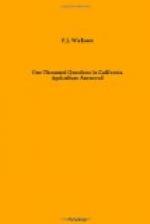Grape Pomace as Hog Feed.
What is the value of grape pomace as a hog feed?
It has been sold for 50 cents a ton as it comes from the press at the winery and when a person has not got any surplus of other feeds, it is evidently worth that and then some. The only way to feed it is to put it up in a big pile and let the hogs take it as they want it. It will help keep them growing through the winter provided they have other feed with it that might not be sufficient without the pomace.
Proper Feeding of Young Pigs.
If I put two 50-pound shoats to an acre of barley that will yield 10 or 12 sacks of grain, how many months could they be kept there to advantage, and what gain could I expect them to make in that time?
If the pigs have been properly fed and were of good stock, they should have attained a weight of 50 pounds at three or four months of age. Pigs in this condition would be more likely to lose than gain turned on a dry barley field, even if the yield were double what you state. Barley is an excellent fattener for mature hogs, but is a poor food for young growing pigs. Young pigs should have a balanced ration, which may be defined as a little of almost all kinds of feed and not all of any one kind. We have pigs running on a barley field such as you describe, and in addition to the barley we feed them once a day a slop composed of wheat middling and bran in equal parts by measurement, to which we add about 8 per cent tankage, and they seem to be moving along nicely. Without the slop we don’t think they would hold their own. — Chas. Goodman.
Pie-melons and Pigs.
I have 14 sows which were fed almost entirely on pie-melons and milk, not much of the latter. Out of the 14, only 3 sows have saved any pigs; the rest lost all the young they had. Four or five sows that for the last three weeks have had no melons, nothing but green grass and a little whole barley each day, are saving their pigs all right.
Pie-melons are poor feed and pigs which are not given anything better ought to fail. “Green grass and a little whole barley” is much better feed than pie-melons. Pie-melons are useful fed with alfalfa hay or some richer food.
Wheat or Barley for Hogs.
Which would be the better grain for me to buy for hog feed; wheat at $1.30 per hundred, or barley at $1? Would it be worth paying 10 cents a hundred for rolling, and then haul the grain 8 miles by wagon?
Wheat is only considered about 10 per cent more valuable as a hog feed than barley, so that in your case, barley at $1 is the cheaper. In Bulletin 80 of the Oregon Station it was found that crushed wheat was 29 per cent more efficient than the whole grain, and it is safe to say that barley will run about the same, enough so at any rate to pay the extra 10 cents a hundred for crushing and the hauling.
Grain and Pasture for Pigs.
What is the most profitable amount of grain to feed to spring pigs while on alfalfa pasture, from the time of weaning to the time of marketing?




